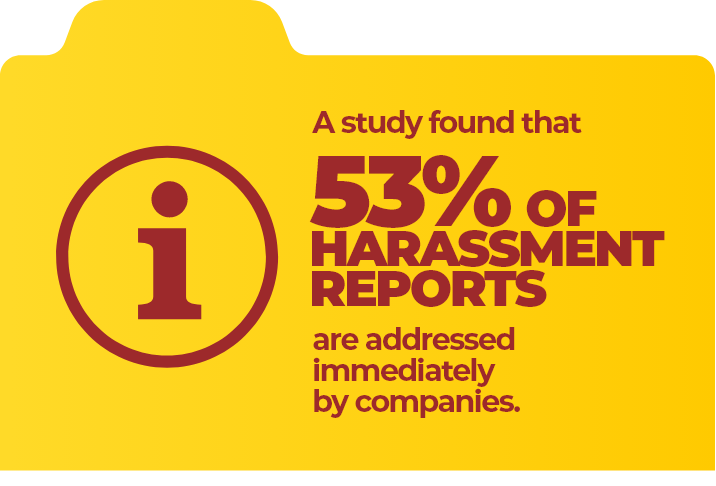Hostile Work
ENVIRONMENT?










WHAT ARE THE LAWS
ASSOCIATED WITH
HOSTILE WORK ENVIRONMENT?

State & City
HUMAN RIGHTS LAW
ADMINISTRATIVE CODE OF
THE CITY OF NEW YORK
HUMAN RIGHTS LAW

Federal
CIVIL RIGHTS ACT OF 1964
DISABILITIES ACT OF 1964

WHAT DOES A
HOSTILE WORK
ENVIRONMENT
LOOK LIKE?
5 things that may indicate a hostile work environment
When there is discriminatory animus and the yelling or actions are directed towards an isolated group of employee(s), based on a protected class like their race, ethnicity, sex, sexual orientation/gender identity, etc, it can constitute a hostile work environment that violates the law.

RELIGIOUS
DISCRIMINATION
Supervisors make offensive jokes about an employee’s religious attire on a daily basis.
RACISM AND
XENOPHOBIA
A supervisor screams one loud racial slur to address a person of color in the office, and all colleagues in the office, including the person of color, hear the slur.
AGEISM
Younger colleagues make repeated offensive gestures and jokes directed toward a 55-year-old worker regarding his age. The worker brings the case to supervisors, but they dismiss it as young kids having fun.
CONVICTION
DISCRIMINATION
A manager/supervisor makes repeated jokes about an employee’s past arrest record in high school.
SEXISM AND
SEXUAL MISCONDUCT
A coworker often plays pornographic videos during his lunch break in the lunchroom. The manager knows about it but does not do anything about it.
A team manager who makes repeated daily remarks about women’s incompetence in front of the female workers in the office.
The manager makes daily remarks about a female coworker’s sexual appearance and appeal.
A coworker keeps expressing sexually charged noises around a group of male coworkers.
CCTV cameras capture a coworker walking up to another coworker unprovoked and groping his genital area.
The manager keeps bringing up conversations about sex to a group of coworkers.

A HOSTILE WORK
ENVIRONMENT IS NOT:
An environment where managers and supervisors constantly yell, shout, and set unrealistic expectations and goals does not constitute a hostile work environment.
Examples
- A boss who is a jerk to everyone, regardless of their protected status
- Managers set unrealistic goals for employees and are rude to everybody when the goals are not met.
- A manager who constantly criticizes the work of employees, and never acknowledges good work.
- The manager constantly mentions a certain employee’s name when discussing past mistakes that had happened, and that employee keeps overhearing it
- A boss always shuts down the ideas of subordinates and humiliates them by mocking them and making sarcastic comments about those ideas
- A supervisor excessively monitoring the work and activity of one worker
- Taking credit for somebody else’s work
- Setting up somebody to fail and then making jokes about it.
- Blaming a colleague for something they did not cause
- Purposely excluding or marginalizing somebody from social interactions in the office
- A manager gives an employee extremely little work or very easy and seemingly unimportant work.
When is
Enough, Enough?
When should you feel that the action(s) dealt upon you at work is enough to bring about a
HOSTILE WORK ENVIRONMENT HARASSMENT case in New York City?
The action(s) that happened is more than “petty slights and trivial inconveniences.” This means that to a reasonable person, they are severe enough to invoke a HWE
The action(s) were targeted at one or more protected classes that you belong to.
(Remember, NYC protects a victim in a lot more personal characteristics than the state or federal laws)
If the action(s) attacks your protected class of gender and sex, it can also classify as
QUID PRO QUO SEXUAL HARASSMENT
alongside a HWE case.

reported quid pro quo sexual harassment or sexual harassment creating a hostile work environment, amounting to
3.9 MILLION PEOPLE STATEWIDE.

What Are Your
Next Steps?


Know you're
Not Alone.
61% OF EMPLOYEES in the country witness or experience discrimination at the workplace, and in 2020, the U.S. Equal Employment Opportunity Commission EEOC) successfully resolved 78,804 charges throughout the country.

Consult
an Expert.
Seek the advice of an employment lawyer with a track record of successful cases.

File A Complaint.
If you did not already, you should consider filing an official complaint with the human resources of your company or your supervisor. This can stir other employees to stop being complacent and follow your steps, thus increasing the strength of the case.


COLLECT EVIDENCE.
Gather as much evidence documenting all of the cases as possible, both digitally through video and picture, or physically through written documents. It is especially important if there is harassment through remote work. 38% of employees face harassment while working remotely.

Find Witnesses.
Try to find witnesses that will be willing to testify on your behalf.
WHY SHOULD YOU
HIRE A LAWYER?

In situations like these where it could feel overwhelming and alien, having a person in your corner who understands your situation and is defending your interests and rights will take a lot of the burden off of your shoulders.
A lawyer can utilize their knowledge and adept experience to navigate the complex legal system successfully, including necessary steps, with your best interests in mind. They will know when to push, and when to pull.

